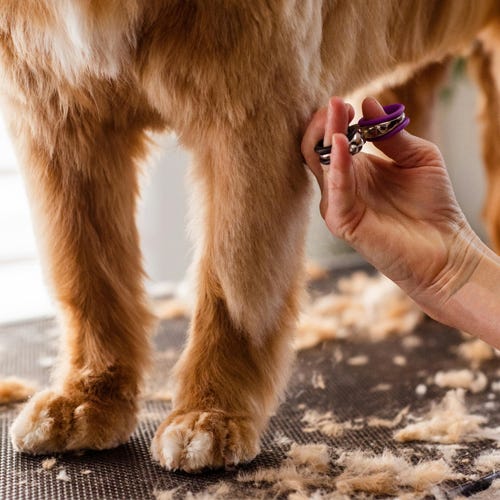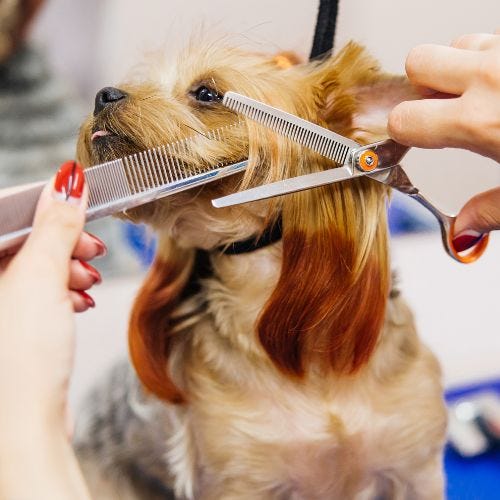Protect Your Business, Your Clients, Your Employees, and Yourself from Dangerous Pests This Summer
05/22/2016
It was quite the lovely winter here in the northeast. Each time the deep freeze hit with subzero temperatures, it rebounded to unseasonably warm temperatures for days on end. This has been great for dogs that love the outdoors, but does not bode well for the spring flea and tick season, which is why we recommend preparing for it now—It could be a record breaking one. All it takes for ticks to appear are a few warm days in a row. Both fleas and ticks thrive in moist, warm weather, and it seems the northeast at least has gotten an early start on these pests. Daryl Conner, well-known industry speaker and proprietor of FairWinds Grooming Studio in rural Appleton, Maine, was seeing ticks weeks ago. “Normally we don’t see them around here until at least May,” says Conner. “But I’ve found them on several clients already.”
Why are groomers so concerned with these pests? Because as trained pet professionals, we know the risks. Not only can flea and tick bites cause discomfort and skin conditions, but they can transmit dangerous diseases and other parasites, too.
Ticks can be more than a fairly disgusting pest. Lyme disease can be transmitted to humans and pets through the bite of an infected tick, as can several other illnesses, such as Erlichiosis, Rocky Mountain Spotted Fever, Anaplasmosis, (each of which is zoonotic, meaning it can be transmitted to people as well as to dogs), Babesiosis, and Hepatozoonosis. While some of these diseases and the ticks that carry them can be found all over the United States (and some worldwide), others are regional—Dogsandticks.com has a map that can show you what tick borne ailments pose the greatest threat to your region.
Some experts believe that ticks do not begin transmitting disease until they are well established and have been sucking blood for at least 24 hours, making products that kill ticks within a day or two useful. Others say that is too generous an estimate, and disease transmission may begin much sooner. Most of us would agree that doing what we can to prevent these pests from latching on in the first place is a good plan.
Suggest that your customers avoid heavily wooded areas when walking their dogs at the height of tick season, or if that isn’t a good option, then make sure humans stay on trails and wear long pants and long-sleeved shirts. Showering as soon as possible after a walk will help wash away ticks, and allow you to check carefully for them. Ticks tend to go for warmer parts, so check heads/necks/armpits/groin/belly button, especially on children. Dogs should be brushed or combed after walks, and areas that ticks like should be checked carefully—neck, armpits, head and ears.
Fleas are sure to follow shortly after tick season in most areas of the country. While they may not carry as many diseases as ticks, the ones that fleas DO carry can be pretty nasty. Besides a few bacterial diseases, anemia, and spreading tapeworms (mostly to dogs, although children are at some risk too), fleas are likely responsible for many of the plague outbreaks in the world. That’s something not to be taken lightly.
Fleas are harder for pet owners to find, as they move so quickly, so you may want to suggest checking for “flea dirt” instead of the actual pests themselves. Flea dirt is that charming mix of dried blood that fleas excrete, and is often found in its highest concentration just in front of the tail. If a customer that sees it thinks it’s just regular garden-variety dirt, tell them to smear some on a damp paper towel—flea dirt will smear with a characteristic dark brown/red color, while dirt will roll, but usually remain intact.
Why would a groomer need to prove to a client that their dog does have fleas? That can be a little complicated. First, fleas have a built-in “ick” factor—people think that fleas are horrid and dirty, and therefore if your dog has them, your house must be horrid and dirty, as well. It is astounding how many times the matter of fact announcement of “Your dog has some fleas” is answered with a heartfelt cry of “But my house is CLEAN!!” No matter how many times I assure customers that it is not a factor, that in fact fleas may enjoy a tidy environment, the stigma remains in customers’ minds. Second, since no customer wants to feel as though they have those icky fleas in their home or yard, it must be someone else’s fault. And where is it more logical—and easier—to assume that their dog got fleas than a place where dozens of dogs go to be cleaned? You’ve got it—YOU, the groomer. Who hasn’t heard it when telling a customer there will be an additional $15 charge for a flea bath on a dog that’s clearly been infested for weeks—“Well, he must have gotten them there because he didn’t have them when I brought him in!”
Sometimes the best defense is to be proactive, and that’s certainly true about fleas and ticks. Most pet parents need only be worried about ticks when they are outdoors hiking or walking with their dog. Fleas are a concern only when they are brought into the pet’s immediate environment and create an infestation. Groomers, however, have to worry about the pests that are brought right to them, whether it’s in the salon or a mobile unit. And they have to worry about their customers’ concerns as to whether their animal could pick up pests at the groomer’s.
Some businesses require that all four legged clients be on some form of flea prevention year round in order to accept them as a client. Others simply do not take animals with fleas in for grooming. The majority accept it as part of the grooming process and assist the customer in making choices for prevention and treatment. It’s an excellent source of income to provide what customers need to help prevent fleas and ticks on their pets, as well as a good business practice. Selling whatever over the counter deterrent local veterinarians suggest is one route to take, whether it is topically applied, spray-on, or a collar. Some businesses ask customers to sign their permission to give the dog a Capstar or Capguard tablet and a flea bath if signs of pests are seen (at the pet owner’s expense, of course).
How else do we, as groomers, help prevent pests brought to us from leaving on other customers’ dogs?
The old saying, “an ounce of prevention is worth a pound of cure” comes to mind right away. It’s best to not have to deal with an infestation that has already occurred if it can be prevented. Checking each and every animal as it comes in the door for parasites is certainly helpful for fleas, but ticks often leave no sign of their presence unless there are many attached to a single dog. With a thick-coated dog, it may not be until the dog is being force dried that ticks are seen.
Groomers spend a lot of time cleaning, disinfecting, and otherwise working to ensure that diseases are not passed from one pet to another, or germs from a pet to equipment or the environment. Besides carefully explaining all those protocols and those for ensuring that fleas are less likely to enter the salon or mobile unit in the first place, there is one exciting new idea in flea and tick prevention that should really help to put customer’s minds at ease.
Insect Shield products, specifically designed for pet professionals.
A revolutionary defense in the ongoing battle against bugs, Insect Shield is a technology for treating fabric that repels fleas and ticks, as well as mosquitoes, ants, flies, chiggers, and midges. Insect Shield products feature a proprietary permethrin formula bound tightly to fabric fibers, for long-lasing, built-in protection.
Similar technology has been used in military apparel for many years, and it has now been approved by the Environmental Protection Agency for use in the pet industry.
Many groomers provide customers with a bandana after grooming, whether included in the price of services or as an add-on. Insect Shield technology has been bound to polyester/cotton blend bandannas and will continue to work through 25 washings. Consider using these in your salon instead of standard bandannas. Insect Shield Groomer Bandana Packs include six bandanas in an eye-catching green paisley for $17.99 (or just $2.99 each). Bandannas are 19” x 19” so could be cut down for smaller pets. Most pet owners would be happy to spend $5 or so for a bandanna that would help deter pests.
This great technology has also been used in pet mats. Insect Shield Kennel Mats offer effective, odorless, built-in protection from disease-carrying insects. Place them in cages or areas where finished pets are kept while waiting to go home. Any customer that expresses concern about fleas and ticks in the environment will be delighted to see that you have taken specific steps to prevent it. Insect Shield Kennel Mats are attractive, comfortable, and the insect protection they offer is long-lasting. With three size options available, there’s one to fit just about any cage. Removable covers can be tossed right in the wash with your towels, and will provide protection through 25 washes. After that, they still make a great bed. Consider also selling these to customers for greater peace of mind at home.
I don’t think anyone likes fleas. Even we, as pet professionals, sometimes get a little squeamish over their possible presence. I don’t know about you, but I’ve actually washed my hair in flea shampoo at the end of a day of flea-full dogs, so here’s another great use of the Insect Shield process; groomer apparel.
A fashionable pullover nylon top in purple with gray panels, Insect Shield V-Neck Tops are available in sizes to fit most groomers (from size 6 to size 20). Be sure that you will not be carrying any “hitchhikers” home to your own pets. It’s also one more factor to assure customers that they won’t go home to their pets, either. The top will withstand up to 70 washings and still prove effective.
Don’t forget to ask about PetEdge’s free window decal advertising Insect Shield product. If you purchase more than $100 of these groundbreaking products, you can get a decal (IE1611 06) to help show your customers you are on top of the pest problem.
For more information on Insect Shield products designed for at-home use, and to view informative videos that showcase these groundbreaking products and demonstrate the efficacy of Inset Shield technology, visit InsectShieldForPets.com.





